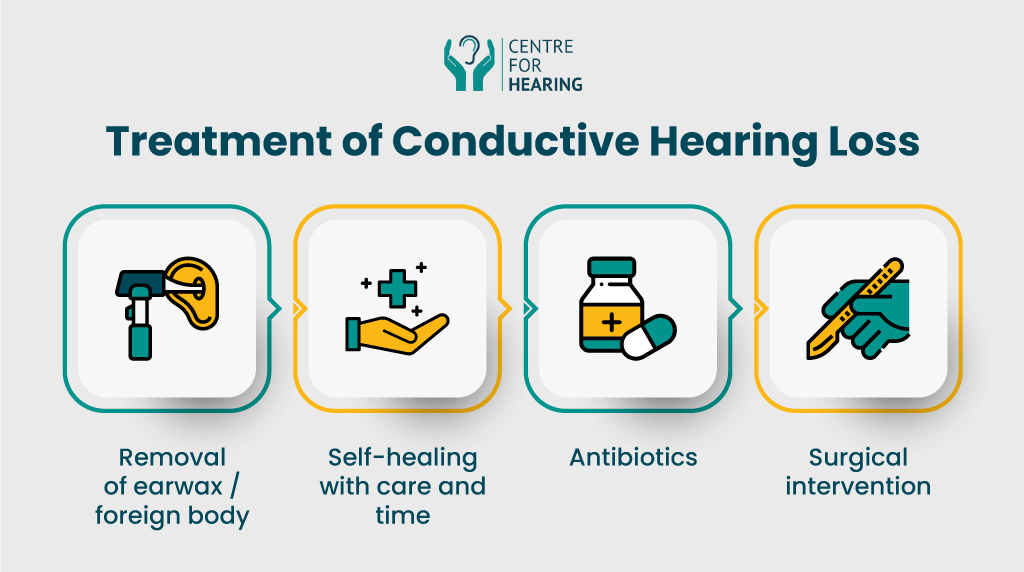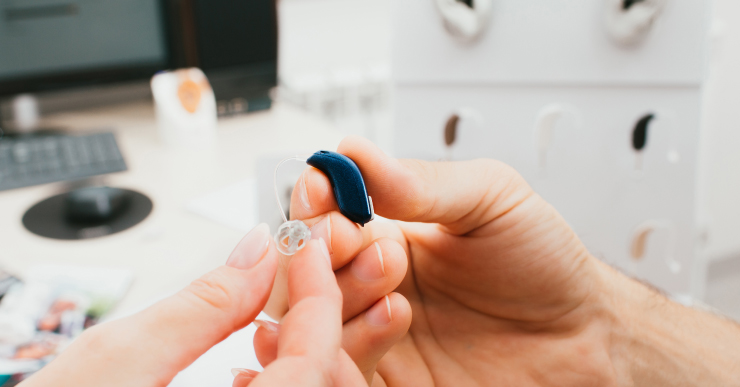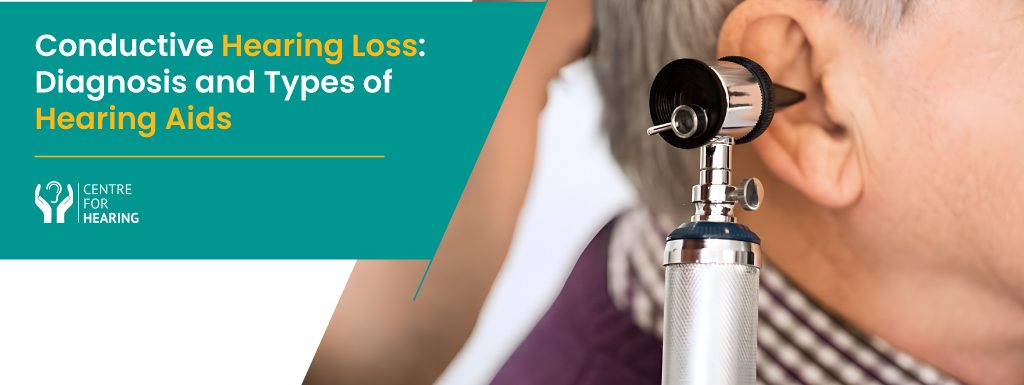If you or a family member complains of trouble with hearing or other discomfort regarding the ear, you may initially be inclined not to pay too much attention to the issue. We often attribute this discomfort to a ‘blocked feeling in the ears’ or to common colds and flu. However, these middle ear issues could cause temporary hearing issues and need to be investigated sooner rather than later.
Ignoring these problems until they have become very severe can be incredibly dangerous for your or your child’s long-term hearing health, as they likely suffer from conductive hearing loss.
While this can usually be resolved relatively easily and quickly if detected early, leaving it untreated can open up possibilities of long-term damage.
Read on to find out exactly what this condition is, how you can recognise its first signs, and the various treatments available, including two types of hearing aids that help.
What is Conductive Hearing Loss?

Broadly speaking, there are three kinds of hearing loss:
- Sensorineural
- Conductive
- Mixed.
Sensorineural hearing loss results from damage to the stereocilia, tiny hair cells in the inner ear responsible for detecting sound.
On the other hand, if hearing loss occurs because of a problem transmitting sound from the outer ear to the cochlea, it’s called conductive hearing loss. This is a middle ear condition and does not affect the inner ear or the ‘cochlea’,
Unlike sensorineural hearing loss, which mostly affects older people, this hearing loss is common in children and adults alike.
The Causes of Conductive Hearing Loss
The symptoms of conductive hearing loss can vary widely, depending on the severity of the hearing loss and what caused it in the first place.
Causes impacting the outer ear
Some of these causes are associated with the outer ear and tend to be easier to treat. These include:
- excessive earwax production
- swimmer’s ear
- foreign bodies becoming lodged in the ear.
It’s not hard to see why this ailment affects children, with their athletic lifestyles and tendency to shove household objects and playthings alike where they don’t belong the most.
Causes impacting the middle ear
Conductive hearing loss due to problems with the middle ear, however, can be more serious and require long-term treatment, such as with different types of hearing aids.
These include middle ear infections and damage to various middle ear structures, including the ear drum and the numerous tiny bones present in the ear.
Diagnosing Conductive Hearing Loss
Diagnosis of conductive hearing loss might require you to undertake a few simple tests. Your ENT is the right person to recommend what is needed.
- Rinne & Weber
- Pure Tone Audiometry
- Impedance Audiometry or Tympanometry
Common Symptoms of Conductive Hearing Loss

- Muffled hearing that may grow worse with time
- A sensation of fullness in the ear, as if it were stuffed with cotton
- Fever
- Pain or soreness in the ear
- Tinnitus, a ringing sound in the ear
- Liquid draining from the ears
- Dizziness
How Is Conductive Hearing Loss Treated?

The treatment for conductive hearing loss is dependent upon what caused it in the first place.
1. Removal of earwax/foreign body
If excessive earwax or a foreign body(s) has blocked off the ear canal, your doctor may simply extract it using precise tools or suction it out.
Unless the objects caused significant injury to your ear alongside blocking it, you’ll make a full recovery and only need to take a few precautions and medicines right after the procedure.
2. Self-healing with care and time
The human body’s capacity to heal itself is extraordinary, so some issues may resolve themselves given time, diligent care and supervision by a medical professional. These include many ear infections, fluid build-ups in the ear and ruptured eardrums.
3. Antibitoitcs
More severe infections, particularly if they tend to recur in a patient, need to be treated with antibiotics. Eardrum injuries that do not heal on their own and damage to or unusual growths in other parts of the ear may only be treatable via surgery.
4. Surgical intervention
Certain middle ear conditions require surgical intervention. For example, if there is an issue with the small bones in your middle ear – it could require a procedure known as a stapedectomy. Another matter might be a ruptured or damaged eardrum. On occasion, it simply recovers with oral medication, but if the damage is big, it might require a surgical process known as a ‘tympanoplasty’ or a ‘myringoplasty’.
There are other conditions, too, which might require surgical intervention.
Treatment Via Types of Hearing Aids

A hearing aid is your best option if other treatments do not alleviate the hearing loss. These devices, which are increasingly sophisticated and inconspicuous, will allow you to enhance your quality of life.
For those with conductive hearing loss, there are two types of hearing aids:
1. Conventional Hearing Aids
The most popular option, with 90% of those diagnosed with hearing impairment using one, is probably what you picture when you think of a hearing aid.
A simple appointment with a hearing specialist is all you need to get fitted for one, with no surgical intervention necessary.
Depending on the severity of your hearing loss, budget, and several other factors, these can range from almost completely invisible devices implanted into the ear to larger but effective over-ear aids.
2. Bone-Anchored Hearing Aids
BAHAs, or bone-anchored hearing aids, are surgically implanted devices. In contrast to conventional aids, which amplify sounds that enter the ear canal, treat hearing loss by conducting sound vibrations to the inner ear via bones.
The prospect of using a hearing implant rather than an external device may be nerve-wracking, but the procedure is simple. The surgery will be an outpatient procedure, and after a brief recovery period, your hearing should be as sharp as ever.
There are a number of reasons why you may prefer BAHAs over conventional types of hearing aids:
- First, conductive hearing loss generally affects the outer and middle ear structures. Since BAHAs are suitable for people with problems in these parts of the ear, they are the perfect fit.
- Second, conductive hearing loss is often a result of severe and recurring ear infections, which conventional hearing aids may exacerbate.
- Other conditions that cause conductive hearing loss, such as irritation in the ear, chronic drainage or excessive earwax production, may also be triggered by conventional aids or simply make them ineffective.
- Many children also benefit from BAHAs, as they may be unable to wear regular aids.
Final Note
While sensorineural hearing loss may take years to develop, speed and accuracy are often of the essence when treating conductive hearing loss.
If you recognise any of the symptoms we’ve listed in yourself or a loved one, consult a doctor immediately.
The Centre for Hearing® will ensure you receive the highest quality diagnosis and treatment, no matter your route.
Moreover, if one of the many types of hearing aids is the best option for you, our strictly brand-agnostic approach means that the device you choose will be tailored perfectly to your needs.
Book your free consultation here today!
Locate a Hearing Aids Centre Near You:

